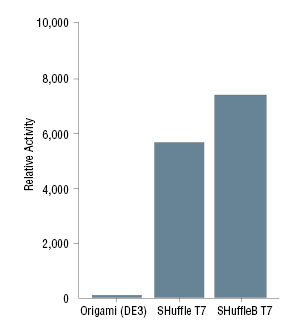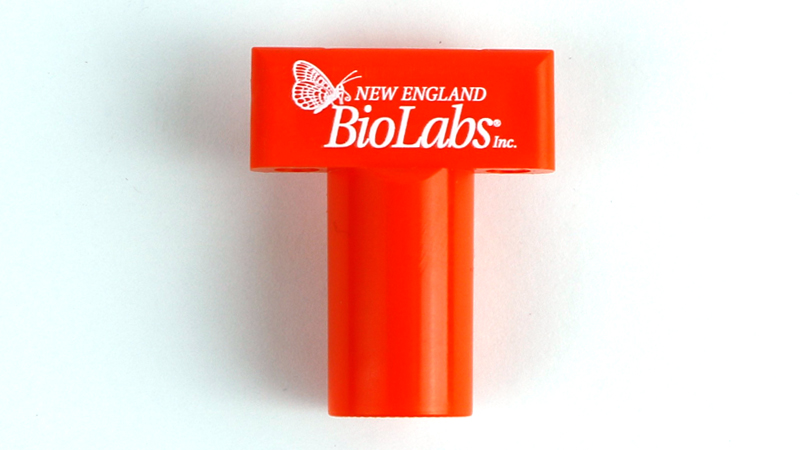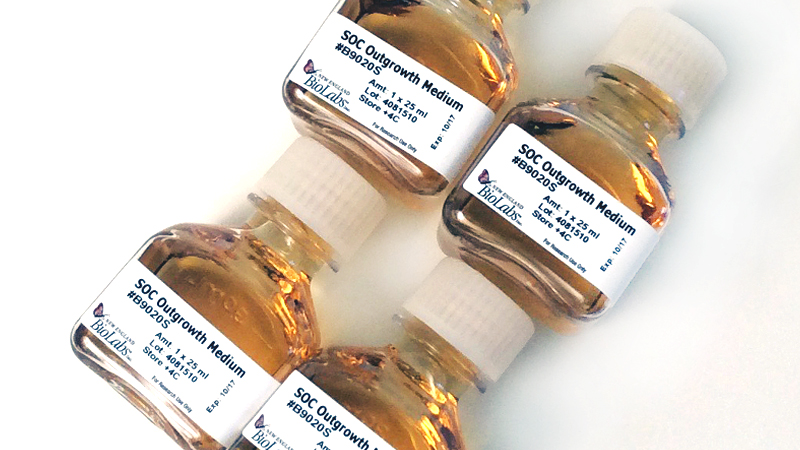SHuffle® T7 Express Competent E. coli
Product information| Code | Name | Size | Quantity | Price | |
|---|---|---|---|---|---|
C3029J |
SHuffle T7 Express Competent E. coli |
12 assays | - | Unavailable in your region |
SHuffle® T7 Express Competent E. coli
Having trouble opening your tubes? NEB Tube Opener can help!
Product Introduction
Chemically competent E. coli cells suitable for T7 protein expression with enhanced capacity to correctly fold proteins with multiple disulfide bonds in the cytoplasm.
- T7 expression
- Engineered E. coli B strain to promote disulfide bond formation in the cytoplasm
- Deficient in proteases Lon and OmpT
- Resistant to phage T1 (fhuA2)
- Free of animal products
- No dry ice charge to competent cell shipments
| Catalog # | Size | Concentration |
|---|---|---|
| C3029J | 12.0 x 0.05 ml |
- Product Information
- Protocols, Manuals & Usage
- Tools & Resources
- FAQs & Troubleshooting
- Citations & Technical Literature
- Quality, Safety & Legal
- Other Products You May Be Interested In
Product Information
Description
Highlights
- Engineered E. coli B strain to promote disulfide bond formation in the cytoplasm
- Constitutively expresses a chromosomal copy of the disufide bond isomerase DsbC
- DsbC promotes the correction of mis-oxidized proteins into their correct form (1,3)
- The cytoplasmic DsbC is also a chaperone that can assist in the folding of proteins that do not require disulfide bonds (4)
- Enhanced BL21 derivative
- Expresses a chromosomal copy of T7 RNAP
- Activity of nonspecific endonuclease I (endA1) eliminated for highest quality plasmid preparations
- Deficient in proteases Lon and OmpT
- Resistance to phage T1 (fhuA2), Nit, Spec, Str*
*Resistance to low levels of streptomycin may be observed.
Transformation Efficiency
1 x 107 cfu/µg pUC19 DNAChemically competent E. coli B cells engineered to form proteins containing disulfide bonds in the cytoplasm. Suitable for T7 promoter driven protein expression.
Genotype
fhuA2 lacZ::T7 gene1 [lon] ompT ahpC gal λatt::pNEB3-r1-cDsbC (SpecR, lacIq) ΔtrxB sulA11 R(mcr-73::miniTn10--TetS)2 [dcm] R(zgb-210::Tn10 --TetS) endA1 Δgor Δ(mcrC-mrr)114::IS10- This product is related to the following categories:
- SHuffle Expression,
- E. coli Protein Expression Strains Products,
- Protein Expression Products,
- E. coli Expression Strains Products,
- This product can be used in the following applications:
- T7 Expression,
- Expression of Difficult Proteins,
- Disulfide-bonded Protein Expression,
- Protein Expression in E. Coli, Protein Expression
Reagents Supplied
Reagents Supplied
The following reagents are supplied with this product:
| NEB # | Component Name | Component # | Stored at (°C) | Amount | Concentration | |
|---|---|---|---|---|---|---|
Properties & Usage
Antibiotic for Plasmid Selection
| Antibiotics for Plasmid Selection | Working Concentration |
|---|---|
| Ampicillin | 100 µg/ml |
| Carbenicillin | 100 µg/ml |
| Chloramphenicol | 33 µg/ml |
| Kanamycin | 30 µg/ml |
| Tetracycline | 15 µg/ml |
Shipping Notes
- Ships on dry ice
Antibiotic Resistance
- str (resistance to low levels of streptomycin may be observed)
- nit
- spec
Features
- T7 expression
- Protease deficient/B strain
- Enhanced capacity to correctly fold proteins with multiple disulfide bonds in the cytoplasm
Application Features


Related Products
Companion Products
Product Notes
- STORAGE AND HANDLING: Competent cells should be stored at -80°C. Storage at -20°C will result in a significant decrease in transformation efficiency. Cells lose efficiency whenever they are warmed above -80°C, even if they do not thaw.
References
- Bessette, P.H. et al. (1999). Proc. Natl. Acad. Sci. USA. 96, 13703-13708.
- Qiu, J., Swartz, J.R. and Georgiou, G. (1999). Appl. Environ. Microbiol. 64, 4891-4896.
- Levy, R. et al. (2001). Protein Expr. Purif. 23, 338-347.
- Chen, J. et al. (1999). J. Biol. Chem. 274, 19601-19605.
- Boyd, D. et al. (2000). J. Bacteriol. 182, 842-847.
- de Marco, A. (2009). Microbial Cell Factories. 8, 26.
Protocols, Manuals & Usage
Protocols
Usage & Guidelines
Application Notes
Tools & Resources
Selection Charts
FAQs & Troubleshooting
FAQs
- What are the strain properties (C3029)?
- What applications are SHuffle® strains useful for?
- Does my protein have disulfide bonds?
- Which SHuffle® strain should I use?
- Is there anything I can do to increase protein yield when using SHuffle strains?
- What are the growth characteristics of the SHuffle strains?
- How do SHuffle® strains aid in cytoplasmic disulfide bond formation?
- Can I store competent cells at -20°C instead of -80°C?
- How should I express my protein of interest in SHuffle?
- Does Streptomycin and/or Spectinomycin need to be added when growing SHuffle strains?
- Can I conduct M13 phage display experiments in SHuffle strains?
- Can I conduct blue/white screening using alpha complementation of lacZ in SHuffle strains?
- Which SHuffle strains are resistant to chloramphenicol? Is chloramphenicol required for maintenance of the mini F plasmid?
- Do SHuffle cells grow in minimal media?
- Are SHuffle strains temperature sensitive?
- Is the genome of SHuffle strains available?
- Is T7 expression subject to catabolite repression in NEB T7 Express or SHuffle strains?
- Can one use SHuffle cells to secrete my protein of interest?
Citations & Technical Literature
Citations
Additional Citations
- Agrawal, A., Bisharyan, Y., Papoyan, A, Bednenko, J., Cardarelli, J., Yao, M., Clark, T., Berkmen, M., Ke, N., Colussi, P. (2019) Fusion to Tetrahymena thermophila granule lattice protein 1 confers solubility to sexual stage malaria antigens in Escherichia coli. Protein Expr Purif; 153, 7-17. PubMedID: 30081196, DOI: 10.1016/j.pep.2018.08.001.
- Robinson, M.-P., Ke, N., Lobstein, J., Peterson, C., Szkodny, A., Mansell, T.J., Tuckey, C., Riggs, P.D., Colussi, P.A., Noren, C.J., Taron, C.H., Delisa, M.P., Berkmen, M. (2015) Efficient expression of full-length antibodies in the cytoplasm of engineered bacteria Nat Commun; (6)8072, PubMedID: 26311203, DOI: 10.1038/ncomms9072.
- Leith, E.M., O'Dell, W.B., Ke, N., McClung, C., Berkmen, M., Bergonzo, C., Brinson, R.G., Kelman, Z (2019) Characterization of the internal translation initiation region in monoclonal antibodies expressed in Escherichia coli J Biol Chem; 294(48), 18046-18056.. PubMedID: 31604819, DOI: 10.1074/jbc.RA119.011008
- Anton, B.P., Fomenkov, A., Raleigh, E.A. and Berkmen, M. (2016) Complete Genome Sequence of the Engineered Escherichia coli SHuffle Strains and Their Wild-Type Parents Genome Announc; Mar 31;4(2), PubMedID: 27034504, DOI: 10.1128/genomeA.00230-16.
- Berkmen, M. (2012) Production of disulfide-bonded proteins in Escherichia coli Protein Expr Purif; 240-251. PubMedID: 22085722
- Reddy, P.T., Brinson, R.G., Hoopes, J.T., McClung, C., Ke, N., Kashi, L. (2018) Platform development for expression and purification of stable isotope labeled monoclonal antibodies in Escherichia coli. mAbs MAbs; 10 (7), 992-1002. PubMedID: 30060704, DOI: 10.1080/19420862.2018.1496879
- Ren, G., Ke, N. and Berkmen, M. (2016) Use of the Shuffle Strains in Production of Proteins. Curr Protoc Protein Sci; Aug 1, 1;85:5.26.1-5.26.21.. PubMedID: 27479507 , DOI: 10.1002/cpps.11.
Publications
- Robinson, M.-P., Ke, N., Lobstein, J., Peterson, C., Szkodny, A., Mansell, T.J., Tuckey, C., Riggs, P.D., Colussi, P.A., Noren, C.J., Taron, C.H., Delisa, M.P., Berkmen, M. (2015) Efficient expression of full-length antibodies in the cytoplasm of engineered bacteria Nat Commun; (6)8072, PubMedID: 26311203, DOI: 10.1038/ncomms9072.
- Reddy, P.T., Brinson, R.G., Hoopes, J.T., McClung, C., Ke, N., Kashi, L. (2018) Platform development for expression and purification of stable isotope labeled monoclonal antibodies in Escherichia coli. mAbs MAbs; 10 (7), 992-1002. PubMedID: 30060704, DOI: 10.1080/19420862.2018.1496879
- Anton, B.P., Fomenkov, A., Raleigh, E.A. and Berkmen, M. (2016) Complete Genome Sequence of the Engineered Escherichia coli SHuffle Strains and Their Wild-Type Parents Genome Announc; Mar 31;4(2), PubMedID: 27034504, DOI: 10.1128/genomeA.00230-16.
- Ren, G., Ke, N. and Berkmen, M. (2016) Use of the Shuffle Strains in Production of Proteins. Curr Protoc Protein Sci; Aug 1, 1;85:5.26.1-5.26.21.. PubMedID: 27479507 , DOI: 10.1002/cpps.11.
- Agrawal, A., Bisharyan, Y., Papoyan, A, Bednenko, J., Cardarelli, J., Yao, M., Clark, T., Berkmen, M., Ke, N., Colussi, P. (2019) Fusion to Tetrahymena thermophila granule lattice protein 1 confers solubility to sexual stage malaria antigens in Escherichia coli. Protein Expr Purif; 153, 7-17. PubMedID: 30081196, DOI: 10.1016/j.pep.2018.08.001.
- Leith, E.M., O'Dell, W.B., Ke, N., McClung, C., Berkmen, M., Bergonzo, C., Brinson, R.G., Kelman, Z (2019) Characterization of the internal translation initiation region in monoclonal antibodies expressed in Escherichia coli J Biol Chem; 294(48), 18046-18056.. PubMedID: 31604819, DOI: 10.1074/jbc.RA119.011008
Quality, Safety & Legal
Quality Assurance Statement
Quality Control tests are performed on each new lot of NEB product to meet the specifications designated for it. Specifications and individual lot data from the tests that are performed for this particular product can be found and downloaded on the Product Specification Sheet, Certificate of Analysis, data card or product manual. Further information regarding NEB product quality can be found here.Specifications
The Specification sheet is a document that includes the storage temperature, shelf life and the specifications designated for the product. The following file naming structure is used to name these document files: [Product Number]_[Size]_[Version]Certificate Of Analysis
The Certificate of Analysis (COA) is a signed document that includes the storage temperature, expiration date and quality controls for an individual lot. The following file naming structure is used to name these document files: [Product Number]_[Size]_[Version]_[Lot Number]- C3029J_v1_0151702
- C3029J_v1_0151706
- C3029J_v1_0151707
- C3029J_v1_0151710
- C3029J_v1_0161709
- C3029J_v1_0161711
- C3029J_v1_0161712
- C3029J_v1_0161801
- C3029J_v1_0161803
- C3029J_v1_10011529
- C3029J_v1_10014837
- C3029J_v1_10016994
- C3029J_v1_10020250
- C3029J_v1_10023821
- C3029J_v1_10026182
- C3029J_v1_10028549
- C3029J_v1_10030391
- C3029J_v1_10032817
- C3029J_v1_10035676
- C3029J_v1_10037027
- C3029J_v1_10039966
- C3029J_v1_10041919
- C3029J_v1_10043196
- C3029J_v1_10045039
- C3029J_v1_10046415
- C3029J_v1_10048234
- C3029J_v1_10050481
- C3029J_v1_10051983
- C3029J_v1_10055904
- C3029J_v1_10057131
- C3029J_v1_10058079
- C3029J_v1_10059094
- C3029J_v1_10061860
- C3029J_v1_10063267
- C3029J_v1_10065156
- C3029J_v1_10067175
- C3029J_v1_10069050
- C3029J_v1_10069843
- C3029J_v1_10072435
- C3029J_v1_10075473
- C3029J_v1_10076057
- C3029J_v1_10077691
- C3029J_v1_10079071
- C3029J_v1_10080731
- C3029J_v1_10083567
- C3029J_v1_10084665
- C3029J_v1_10087090
- C3029J_v1_10087563
- C3029J_v1_10090645
- C3029J_v1_10094884
- C3029J_v1_10099663
- C3029J_v1_10104347
- C3029J_v1_10108068
- C3029J_v1_10111580
- C3029J_v1_10114694
- C3029J_v1_10117819
- C3029J_v1_10120657
- C3029J_v1_10125853
- C3029J_v1_10129227
- C3029J_v1_10132445
- C3029J_v1_10135796
- C3029J_v1_10140141
- C3029J_v1_10143760
- C3029J_v1_10146579
- C3029J_v1_10149442
- C3029J_v1_10152261
- C3029J_v1_10155350
- C3029J_v1_10158007
- C3029J_v1_10162204
- C3029J_v1_10164858
- C3029J_v1_10168700
- C3029J_v1_10172494
- C3029J_v1_10175056
- C3029J_v1_10178257
- C3029J_v1_10180214
- C3029J_v1_10182865
- C3029J_v1_10184926
- C3029J_v1_10189244
- C3029J_v2_10192542
- C3029J_v2_10198468
- C3029J_v2_10201472
- C3029J_v2_10203037
- C3029J_v2_10204791
- C3029J_v2_10208366
- C3029J_v2_10212261
- C3029J_v2_10215321
- C3029J_v2_10219141
- C3029J_v2_10225531
- C3029J_v2_10227167
- C3029J_v2_10232239
- C3029J_v2_10236185
- C3029J_v2_10237573
Safety DataSheets
The following is a list of Safety Data Sheet (SDS) that apply to this product to help you use it safely.SHuffle® T7 Express Competent E. coli
Legal and Disclaimers
Products and content are covered by one or more patents, trademarks and/or copyrights owned or controlled by New England Biolabs, Inc (NEB). The use of trademark symbols does not necessarily indicate that the name is trademarked in the country where it is being read; it indicates where the content was originally developed. The use of this product may require the buyer to obtain additional third-party intellectual property rights for certain applications. For more information, please email [email protected].This product is intended for research purposes only. This product is not intended to be used for therapeutic or diagnostic purposes in humans or animals.
New England Biolabs (NEB) is committed to practicing ethical science – we believe it is our job as researchers to ask the important questions that when answered will help preserve our quality of life and the world that we live in. However, this research should always be done in safe and ethical manner. Learn more.
Licenses
The buyer and user have a non-exclusive sub-license to use this system or any component thereof for RESEARCH PURPOSES ONLY, based upon agreement to the following assurances.Transfer of the host cells that contain the cloned copy of the T7 gene 1 to third parties is explicitly prohibited. This limitation applies to E. coli ER2566, ER2833, ER3011, ER3012, ER3013 and ER3021, SHuffle T7, SHuffle T7 LysY, SHuffle T7 Express, SHuffle T7 Express LysY and their competent derivatives, C2566, C2833, C3010, C3013, C3016, C3022, C3026, C3027, C3029 and C3030 when provided separately or when provided in combination with appropriate vectors for said systems.
A license to use this system or any components thereof for commercial purposes may be obtained from New England Biolabs, Inc.
Other Products You May Be Interested In
The supporting documents available for this product can be downloaded below.
Protocol
Expression Using SHuffle (C3029)
Protocol
Expression Using SHuffle (C3029)

